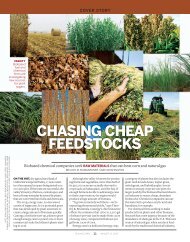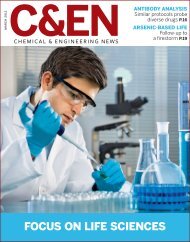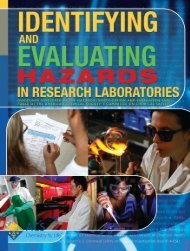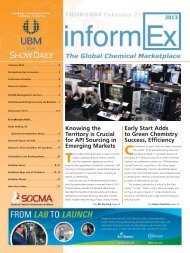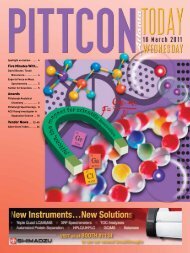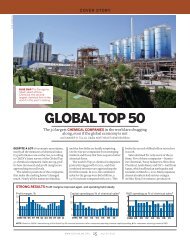CAFFEINE JITTERS
CAFFEINE JITTERS
CAFFEINE JITTERS
- No tags were found...
You also want an ePaper? Increase the reach of your titles
YUMPU automatically turns print PDFs into web optimized ePapers that Google loves.
COVER STORYSHUTTERSTOCK/ISTOCKPHOTO/C&EN<strong>CAFFEINE</strong> <strong>JITTERS</strong>Sales boost in energy drinks and deaths linked to the products make scientistsand regulators WORRY ABOUT SAFE LEVELS of the stimulantLAUREN K. WOLF, C&EN WASHINGTON“I ❤ <strong>CAFFEINE</strong>” Caffeine fiendsthe world over frequently showtheir love for the stimulant andthe buzz it induces.WHEN MATTHEW PENBROSS woke ona morning in August 2007—a day in whichhe’d be competing in motocross races nearPort Macquarie, Australia—he wanted tobe prepared. To improve his reaction speedon the start line, the 28-year-old begandrinking Red Bull Energy Drinks soon afterhe rolled out of bed. All told, he woulddrink seven or eight of the caffeinated beverageswithin a seven-hour period.After his second race that day, Penbrosswasn’t feeling well. But despite some shortlivedchest pains, he kept riding and wenton to win a race in the afternoon. Twentyminutes after he crossed the last finish lineof the day, though, his heart stopped.Penbross had no family history of heartdisease, and he regularly drank a few RedBulls per day, news reports later stated. Thehospital doctors who treated his collapseand helped him recover went on to suggestthat the excessive amount of caffeinatedenergy drinks he consumed was the likelyculprit (Med. J. Aust. 2009, 190, 41).Stories like Penbross’ have surfaced withincreasing frequency in recent years. Accordingto a report released last month bythe U.S. Substance Abuse & Mental HealthServices Administration, the annual numberof emergency room visits associatedwith energy drinks increased to 20,000 in2011, a 36% boost from the previous year.Late last year, the New York Times reportedthat the U.S. Food & Drug Administrationis investigating reports of five deathslinked to Monster Energy drinks and13 deaths linked to 5-Hour Energy shots.As concerns about the safety of theseproducts have risen, so too have theirsales. According to SymphonyIRI Group,a Chicago-based market research firm, themarket for caffeinated energy drinks hit$9.8 billion last year.“People often don’t understand the potentialrisk of these beverages,” says BruceEMERGENCIES Energy drinks arebeing increasingly linked with hospitalvisits in the U.S.ER visits associated with energydrinks, thousands2520151052007 08 09 10 11NOTE: ER visits for 2012 not yet available.SOURCE: Substance Abuse & Mental HealthServices AdministrationA. Goldberger, director of forensic toxicologyat the University of Florida’s pathologylabs. Caffeine is a stimulant and, whenconsumed at high enough levels, can havenegative effects.Monster Energy vigorously defends itsWWW.CEN-ONLINE.ORG 9 FEBRUARY 4, 2013safety record. In response to the fatalityreports FDA is investigating, the companyreleased the following statement: “Neitherthe science nor the facts support the allegationsthat have been made. Monster reiteratesthat its products are and have alwaysbeen safe.” The firm also says a 16-oz canof its product contains only about half thecaffeine found in a 16-oz cup of premiumcoffee, such as Starbucks.Caffeine safety has proven hard to measure.Although scientists have establishedthe toxic dose to be somewhere around10 g, they say that the value can fluctuatedepending on how a person processes thestimulant. Caffeine gets cleared from thebody at different rates because of geneticvariations, gender, and even whether aperson is a smoker. For this reason, it’s difficultto set a safe limit of daily consumptionon the compound. Physiological differences,as well as differences in the waypeople consume caffeine, have tied FDA inknots as it has debated how to regulate thesubstance.Caffeine has long been prized for itsability to increase a person’s alertness andenergy. According to lore, these propertieswere noted in the 9th century by anEthiopian goatherd who found his flockfrolicking after eating coffee berries fromnearby bushes. What is not lore is that caf-“People often don’t understand thepotential risk of these beverages.”
COVER STORYfeine is one of the most frequently ingestedpharmacological substances in the world.People proclaim their love of the chemicalby displaying its structure on T-shirts,mugs, and jewelry. According to FDA, atleast 80% of adults in the U.S. consumecaffeine every day.SCIENTISTS KNOW a lot about how thepopular stimulant triggers alertness in thebody at low doses, says Bertil B. Fredholm,emeritus professor of pharmacology atthe Karolinska Institute, in Sweden. Oncethe compound gets absorbed into thebloodstream, it moves to the liver, whereit is metabolized. There, cytochrome P450enzymes yank different methyl groups offcaffeine to transform it into the primarymetabolites paraxanthine, theophylline,and theobromine.Caffeine and its metabolites subsequentlybind to proteins called adenosinereceptors located throughout the body.When they bind to two of these receptors—namedA 1 and A 2A —the stimulantsblock the proteins from interacting withtheir natural partner, the small moleculeadenosine. Normally, adenosine’s interactionwith its receptors regulates nervecell activity as well as the release of neurotransmitterssuch as dopamine. It alsopromotes sleepiness.But when caffeine or its metabolitesprevent adenosine from doing its job,dopamine and other neurotransmitterlevels increase,leading to a surgein nerve activity in thebrain and on the heart.This action then causesa jump in heart rate andblood pressure.Like other indulgencesin life, however, too muchof a good thing can bebad. “Whereas low-dose caffeine effectsare wakefulness, a little bit of arousal, andslight euphoria,” Fredholm says, “highdoseeffects are anxiety, irritation,and general mental discomfort—acompletely different kettle of fish.”Those negative high-dose effects areespecially worrisome, given that researchersstill don’t fully understand theirorigins.“High-dose caffeine effects are muchmore complex,” Fredholm explains. “It’sstill unknown precisely what the primarymechanism of action is in the brain andelsewhere.”<strong>CAFFEINE</strong>BY THENUMBERSMost beveragescontain lesscaffeinethan therecommendeddaily limit, butsome are toocaffeinatedfor pregnantwomen andchildren.2-oz shot of5-Hour Energy2158-oz cup of coffee(brewed) c1338-oz cup of coffee(instant) c9320-oz bottle of Mountain Dew908-oz can of Red BullEnergy Drink8320-oz bottleof Coca-Cola588-oz cup ofcoffee (decaf) c 5Grande (16 oz)cup of Starbuckscoffee33020-oz bottle of Pepsi Max1152-oz cup of espresso c80758-oz cup of black tea(brewed) c558-oz cup ofhot chocolate c9Caffeine levels, mgRecommendeddaily limit fora healthy adult a400Recommendeddaily limit for apregnant woman b2008-oz can of Monster Energy92Recommended daily limit foran average U.S. 10-year-old aa = Limit proposed by Health Canada. b = Limitproposed by U.K. Food Standards Agency.c = Average value. SOURCES: Consumer Reports,December 2012; Curr. Opin. Pediatr., DOI: 10.1097/mop.0b013e3283506827; J. Am. Med. Assoc., DOI:10.1001/jama.2012.170614; J. Food Sci., DOI:10.1111/j.1750-3841.2010.01561.xWWW.CEN-ONLINE.ORG 10 FEBRUARY 4, 2013The toxic level in humans, about 10 g, isroughly the equivalent of imbibing 75 cupsof brewed coffee (in 8-oz mugs) or 120 cansof Red Bull over a few hours.But that lethal limit can vary widelyfrom person to person, experts say. Caffeineis processed differently in each individual,so setting a precise safety limit isnot a straightforward matter.And standard animal models haven’tbeen much help. “Mice and rats—the animalswe’d normally use to determine lethaldoses of substances—metabolize caffeinemuch more quickly than humans,” saysJames D. Lane, a medical psychologist atDuke University Medical Center. So it’shard to compare the health effects of caffeinein rodents and humans, he adds.For these reasons, scientists have struggledto distinguish benign, low doses ofcaffeine from troublesome, high doses.In 2003, a team at Health Canada, agovernment regulatory agency, reviewedmore than 200 studies about caffeine’s effectson human health. On the basis of thesurvey, the team concluded that 400 mg ofcaffeine per day (or about three 8-oz cupsof brewed coffee) is a safe dose for healthyadults to consume (Food Addit. Contam.,DOI: 10.1080/0265203021000007840). Atand below this level, the average persondoes not experience negative mood changesor heart problems, the report stated.The Health Canada team also recommendeda limit of 2.5 mg per kg bodyweight per day for children.For an average 10-year-old inthe U.S., that’s about 75 mg ofcaffeine, or two 12-oz cans ofCoca-Cola.But these recommended“safe” levels of caffeine are juststatistical averages over thepopulation. Some people toleratecaffeine and can ingest largequantities of the compoundwithout ill effects, and otherscan’t, explains Emma Childs, abehavioral psychopharmacologist atthe University of Chicago.Fifty percent of the caffeine aperson takes in gets cleared fromthe body, on average, in five hours. Butstudies have shown this rate can vary becauseof other drug use: Women taking oralcontraceptives break down caffeine slowerthan those not on a contraceptive pill, andpeople who smoke process the stimulantfaster than those who don’t.Genetics also plays a big role in howSHUTTERSTOCK/C&EN (ALL)
“Neither the science nor the facts supportthe allegations that have been made.”a person reacts to caffeine. For example,men metabolize caffeine faster thanwomen.Scientists have also found that certainDNA sequence variations in the gene codingfor CYP1A2, the main cytochrome P450enzyme that metabolizes caffeine, controlhow fast or slowly a person breaks downthe stimulant. The variations, called singlenucleotidepolymorphisms (SNPs), increasethe levels of the enzyme present in the liver.ALSO INFLUENCING how people reactto caffeine are SNPs in a gene calledADORA2A, which codes across the body forthe adenosine receptor A 2A . For instance,Childs and her group showed in 2008 thatstudy participants with a particular SNP inADORA2A began feeling anxious after consumingonly 150 mg of caffeine. Participantswithout the SNP didn’t experience caffeineinducedanxiety until they had ingested450 mg of the substance (Neuropsychopharmacology,DOI: 10.1038/npp.2008.17).Fortunately, Childs says, “people with theADORA2A polymorphism are pretty cognizantof it.” The gene defect is usually associatedwith panic disorder, she adds. “So thosepeople know how much they’re allowed tohave and when they’ve had too much.”It’s more difficult, Childs says, to adviseslow caffeine metabolizers who have polymorphismsin their CYP1A2 liver enzyme.“Without genetic testing,” she explains,“it’s hard to know whether you need to becareful with intake.”Because of the variability in caffeinesensitivity among people, FDA has stoppedshort of recommending a consumptionlimit for the entire population. The agencygoes only so far as to state on its website,“Experts agree that 600 mg (four to sevencups of coffee) of caffeine or more each dayis too much.”The agency has also found it difficultto regulate the caffeine content of foodand drink. Caffeine is a psychoactive drug,but it is also a natural ingredient in widelyconsumed beverages such as coffee andtea.At one point in the early 1980s, FDA consideredprohibiting the addition of syntheticcaffeine to soft drinks for safety reasons.But beverage manufacturers claimed thecompound was a necessary flavor enhancerfor their products.The agency relented, but it put a limit of0.02% on the amount of compound allowedto be added to cola-type beverages. That’sa concentration of about 6 mg per oz, athreshold that drinks like Pepsi Max (5.8 mgper oz) bump up against but don’t surpass.But “beverage” limitations don’t apply todrinks like Monster Energy or 5-Hour Energy.These caffeine-rich products are sold assomething different: dietary supplements.The 1994 Dietary Supplement Health &Education Act allows drinks marketed thisway to contain ingredients such as vitamins,minerals, herbs, and other substancesthat supplement a person’s diet. And if oneHPLC and UHPLCfor biologics development,identification, and QCDrug development workflows in biopharmaceutical laboratoriescan be demanding, requiring extensive data, accurate results, andfast separations. The new Thermo Scientific Dionex UltiMate 3000 BioRS System is specifically designed to power the new highresolution Bio UHPLC columns with unique chemistries to provideincreased structural information. The biocompatible low-dispersionflow path with Thermo Scientific Dionex Viper Fingertight fittingtechnology ensures the highest peak capacity and sensitivity forcomplex samples—proteins, peptides, or biotherapeutics.now in one system• Streamline your biopharmaceutical analytics workflow:thermoscientific.com/BioRS© 2013 Thermo Fisher Scientific Inc. All rights reserved. All trademarks arethe property © 2013 of Thermo Fisher Scientific Scientific Inc. and Inc. its All subsidiaries.rights reserved.WWW.CEN-ONLINE.ORG 11 FEBRUARY 4, 2013
COVER STORYof those substances is caffeine, it is free ofFDA’s 0.02% food-additive restriction.As a result, drinks such as Monster Energymay contain caffeine levels in excessof 6 mg per oz. And because the beveragemanufacturers sometimes include caffeineas part of a drink’s proprietary “energyblend,” the amount of the stimulantdoesn’t need to be reported on the bottles.These blends include compounds such asglucuronolactone and taurine, althoughexperts agree that caffeineis the active ingredient deliveringthe power boost.FDA doesn’t have enoughevidence to stop the practice, saysDaniel Fabricant, director of FDA’sDivision of Dietary SupplementPrograms. “For FDA to seek a limiton any ingredient in a dietary supplement,we have to demonstratethat there is a significant or reasonablerisk of illness or injury underthe normal conditions of use or inthe labeling,” Fabricant says.That happened for Canada in2011 when it announced a limitof 180 mg of caffeine per energydrinkserving. A cap hasn’t been institutedin the U.S., but FDA says it is taking seriouslyreports of five deaths and about 30adverse events possibly linked to MonsterEnergy that have occurred since 2008.FDA released those records after a Freedomof Information Act request was submittedby Wendy Crossland, the mother ofa teenage girl who died in 2011 of a heart arrhythmia.The 14-year-old, Anais Fournier,consumed a 24-oz Monster Energy drinkat a mall near Hagerstown, Md. The nextday, she drank another 24-oz can and thencollapsed.Each can of Monster contains an estimated240 to 280 mg of caffeine, a dailydose that is considered safe for adults.Fournier, however, was younger andsmaller than the average adult and had apreexisting heart condition.“Caffeine will increase adrenaline in yourbody, and it will increase blood pressure,”says Duke’s Lane. For habitual users, “it generallyincreases the wear and tear on yourbody.” Healthy adults don’t typically noticethese mild effects, but the changes can exacerbateunderlying conditions such as heartdisorders, particularly at acute doses.Reports of adverse events connectedwith 5-Hour Energy shots are also beingscrutinized by FDA. Since 2009, the agencyhas received about 90 filings related to theproduct, including records of 13 deaths.Unlike energy drinks, which sit on grocerystore shelves next to sodas and come in 8-to 24-oz cans, energy shots are sold next tothe Tic Tacs and gum at the cash register in2-oz servings.Even though 5-Hour Energy bottles donot list caffeine content, in December, ConsumerReports said the shots contain 215 mgof the stimulant. That’s almost seven timesBUZZ-INDUCINGBREAKDOWNCytochrome P450enzymes in the liverbreak down caffeineinto its primarymetabolites bypulling off methylgroups.H 3 CNNHNONOParaxanthineCH 3CaffeineTheobrominethe concentration of an average cup ofbrewed coffee and 19 times the 0.02% FDAlimit for beverages.Living Essentials, the maker of 5-HourEnergy, has responded to the scrutiny byissuing commercials about its productsafety and by claiming each shot containsthe amount of caffeine in a cup of premiumcoffee, such as Starbucks.“But energy shots aren’t cups of coffee.It’s not comparing apples to apples,” saysGoldberger, the University of Florida toxicologist.“Your typical cup of coffee comeshot; you wouldn’t usually gulp it down.” Onthe other hand, he says, “energy shots comein 2-oz containers that can be gulped.”LACK OF DATA is something else FDAhas been grappling with, says supplementsdirector Fabricant. “Looking into adverseevent reports is challenging because quiteoften, you don’t have a lot of backgroundinformation,” such as the person’s medicalhistory, age, and size or details about exactlywhat happened. “But we’re always reviewingand rereviewing the reports,” he adds.The number of drinks it took to cause anadverse event isn’t listed in the records submittedto FDA either. But a survey of callsto an Australian poison information centerbetween 2004 and 2010 suggests that numbercould be a factor in why people get sick.WWW.CEN-ONLINE.ORG 12 FEBRUARY 4, 2013NNH 3 CNNH 3 CCH 3N OONCH 3N OONHCH 3NNHTheophyllineAbout 200 calls related to energy drinkscame in during the seven-year period, andthe average subject consumed five beveragesbefore feeling ill (Med. J. Aust., DOI:10.5694/mja11.10838).“It’s generally recognized that caffeineis a mildly addictive stimulant drug,” saysMichael F. Jacobson, executive director ofthe Center for Science in the Public Interest(CSPI), a consumer health advocacygroup. Some young adults view itas a legal way of getting high.The average subject involved inthe Australian poison center calls,for instance, was 17 years old. And30% of the time, the subject usedthe energy drinks in combinationwith alcohol or drugs like Ecstasy.“The Federal Trade Commissionprobably needs to look intothe marketing of these products,”O Goldberger contends.That’s because the amped-upmessage attached to energy drinksis quite different from the relaxed,good-to-the-last-drop one associateswith coffee, he says. Oneenergy drink, called Cocaine, oncelabeled itself “the legal alternative.”It’s not just beverages that have beencaught up in the caffeine craze: Ballparkfavorite Cracker Jack will soon come asCracker Jack’d—2-oz packages of thefamiliar candy-coated kernels jammed,in certain flavors, with 70 mg of caffeinefrom coffee. According to the label, they’re“snacks with impact.”Cracker Jack’d will also join caffeineladencandies, waffles, and even pancakesyrup. So far, these items are sold mostly onthe Internet and haven’t caused problems,says CSPI’s Jacobson, “but if they proveto be popular, you can bet there’s going tobe an escalation of small companies sellingthem in stores. Major marketers mightthen see the new niche and capture theirshare of the profits.”Frito-Lay, the maker of Cracker Jack’d,has responded to concerns about its productline by saying it stands behind the safetyof its caffeine-containing kernels. “All marketingfor the products will be exclusivelyaimed at adult consumers, and the packagedesign and appearance are wholly differentfrom Cracker Jack to ensure there is no confusionamong consumers,” Frito-Lay says.CSPI’s Jacobson is not convinced. Thetrend of pumping products full of caffeine,he argues, deserves attention from FDAbefore it gets out of hand. ◾CH 3NNCH 3O



